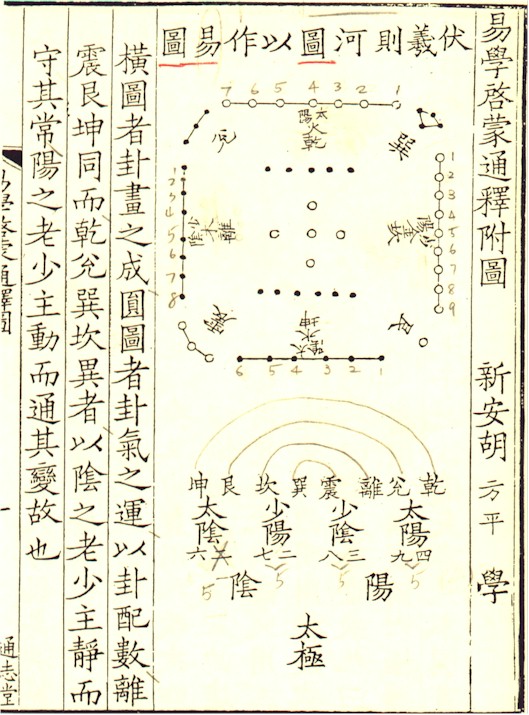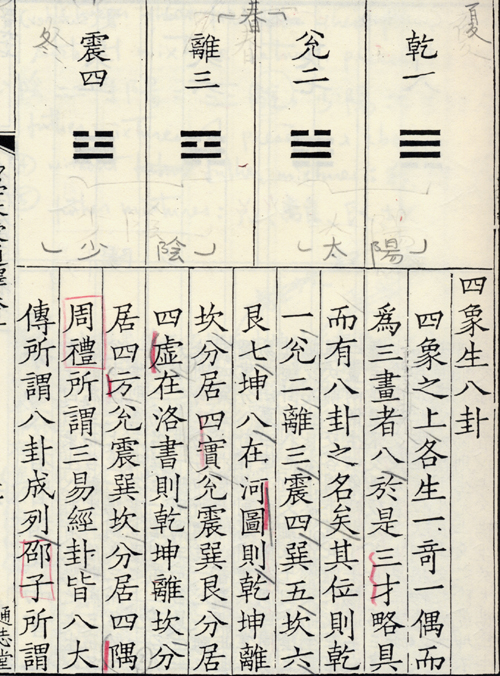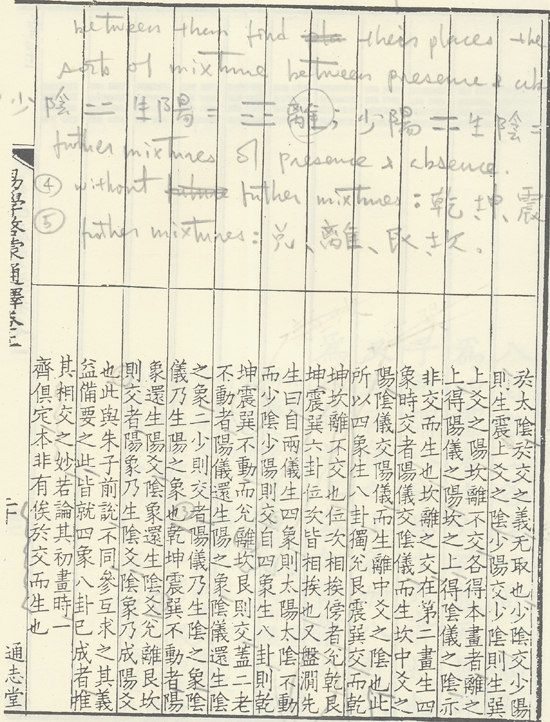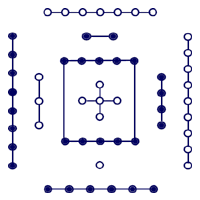
|
Scientific Enlightenment Book 2: Human Enlightenment of the First Axial 2.D.1. The example of the Yijing Metaphysics of Sung Dynasty, China Chapter 2 ACADEMY | previous section | Table of Content | next section | GALLERY |

|
Scientific Enlightenment Book 2: Human Enlightenment of the First Axial 2.D.1. The example of the Yijing Metaphysics of Sung Dynasty, China Chapter 2 ACADEMY | previous section | Table of Content | next section | GALLERY |

The River Diagram
This famous diagram deviates from the expectation with the 8 trigrams. The top side is (South), and belongs to Ultra Yang, and the number of dots is 7, rather than the 9 indicating the intensity of existence. The Lesser Yang on the right (West) has 9 instead of 7. We may expect that 7 on the right (West, sunset, occidentalis, Abendlands, hence 1 less than the 8 of the East) with 8 on the left (East, sun rise, orientalis, anatolia, hence 1 more than the West) makes 15; and 9 on the top + 6 at the bottom = 15. This is however not the case. The River Diagram came from a different source (c.f. Kidder Smith, The Sung Dynasty's Use of I Ching, p. 120), and its combination with the trigrammatic study will be discussed later.1 The trigrammatic structure just arrived at should have such expected arrangement:
Ultra Yang
(fire)
* * * * * * * * *
* *
* *
Lesser Ying * * * Lesser Yang
(wood) * * * * * (metal)
* * *
* *
* *
*
* * * * * *
(water)
Ultra Ying
|
A sure misprint occurs at the bottom, where the stretch of the cosmological constant in one direction into the existence (materiality) of one is coupled with its stretch in the other direction into the spatiality of the other. The left-most coupling for Ultra Ying has 6:2. It should be 6:1. The table of coupling should then be:
Ultra Ying Lesser Yang Lesser Ying Ultra Yang
6 1 7 2 8 3 9 4
|
The text on the left of the diagram explains that the two trigrams (forthcoming, see below) that go with Lesser Ying and the two that go with Ultra Ying are "the same", presumably meaning "the principles of sameness"; the 4 trigrams of Ultra and Lesser Yang are "different", then, "the principles of difference". The next line explains: "because the principles, the Ultra and the Lesser Ying, are those of rest [Ruhe], they are the guardians of permanence, of stability, of things; and because the principles, the Ultra and the Lesser Yang, are those of movement [Bewegung], they are those through which changes may occur of things." Such is then the explication of yi, change, of the Book of Change, Yijing. The self-manifestation of the eternal substrate of conservedness, its shuffling of itself here and there into this and that, its temporo-spatialization, cosmogenesis, is the movement of Yang; and the products of such, this and that, are maintained, temporarily shall we say, by the absence of its movement, Ying.
Materiality, materialization is designated by the intensity of existence. Note, again, that the intensity of existence of a material is inversely proportional to how "material it looks": Ultra Yang, the most existent, is fire, i.e. the least "material-looking". This is because, we shall remember, the intensity of existence increases when the distance toward the non-spatiality and non-temporality of the Eternal Taiji is shorter, and so when materiality decreases in favor of "pure being".
Recall that the elements of classical mechanics are three: mass, position (its change; space), and time elapsed. All phenomena of nature, the motions of things, their velocity, energy, and momentum, are composites of (or relations among) these three. So far, with the Yijing metaphysics, we have two of these: materiality or intensity of existence designated by the number corresponds to mass; spatial privilege or intensity of spatiality designated by position coincides with position. We wait for what Yijing metaphysics has to say about temporalization.
The other numerological derivation is plain. Positional privilege, as less spatiality, is the measure of the distance from total being, total existence of the eternal substrate (Taiji), so that Ultra Yang, with the highest intensity of existence 9, can have this derived from 10 (Taiji) + (-1) (the least spatiality as the shortest distance to, or the smallest fall from, Taiji) = 9. Lesser Ying has its intensity derived from 10 + (-2) (its distance from Taiji or its position) = 8. So Lesser Yang = 10 - 3 = 7, and Ultra Ying = 10 - 4 = 6. This is then diagrammed differently, in the Luo Document.

The Luo Document
The arrangement of the diagram involves other issues which we have not yet touched upon. For now, note only that the 9 dots of Ultra Yang on the top correspond to the 1 dot at the bottom. Same for the 7 dots of Lesser Yang on the right corresponding to the 3 dots on the left. And diagonally, 8 to 2 and 6 to 4. Let us proceed to the next stage of cosmogenesis, the derivation of the 8 trigrams.


|
The four Hsiang give rise to 8 trigrams
On top of four Hsiang are generated one odd and one even, producing those with 3 strokes. Hence the three tsai [才 talents? nature? constitution?] are complete and there are established the names of the eight trigrams. Their positions are Qian [乾 |
The diagrammatic positioning of the trigrams on the River Diagram is fairly obvious and can be seen from above. It is abstracted below. The number represents spatiality; the lower the number for spatiality, the higher the "being", i.e. the greater the intensity of existence, as we recall. Qian is all Yangs , most intensely existing, the least spatial, on the South, with spatial privilege 1. Dui
, with only one Ying, next to Qian in intensity of existence and so of positional privilege 2. Li
, follows at 3, at the center of East. Zhen
, with 2 Yings in its constitution, is less intensely existing, and more spatial, of spatial privilege then of 4, and approaching South. Then we move directly diagonal to Xun
, with only 1 Ying, hence deserving a place next to Qian at the center of South. Kan
, with 2 Yings, is not very be-ing, certainly less than Li, hence at the center of West, the point of sunset, vis-à-vis the more be-ing Li which is sun-rise. Gen
, of 2 Yings within, approaches direct North. Finally, by this second path of lesser being, we reach the direct North, Kun
, of all Yings, the least be-ing, and of the most spatial.
Dui 2 Qian 1 Xun 5
---------------------
| |
| |
| |
| |
Li 3 | | Kan 6
| |
| |
| |
| |
---------------------
Zhen 4 Kun 8 Gen 7
|

Leaving aside the Document for now, let us now focus on how the small print commentary explains the derivation of the trigrams. There are four processes.
1. "The intercourse of Ultra Ying and Ultra Yang produces Gen [艮] and Dui [兌]." That is, Ultra Yang ![]() + Ultra Ying
+ Ultra Ying ![]() = Gen
= Gen and Dui
. Gen comes from Ultra Ying remaining predominant or as the base and being supplemented by Ultra Yang. The text explains: "以太陽過來交太陰, 則生艮上畫之陽" "Ultra Yang comes to intercourse with Ultra Ying, then is produced the Yang on top of Gen." In the genesis of new constituents the actively coming-toward is the supplemental and the passively receiving is the base or the predominant. Dui then comes from Ultra Yang remaining predominant or the base and being supplemented by Ultra Ying. "Ultra Ying comes intercoursing with Ultra Yang and is thus produced the Ying on top of Dui", so the text explains.
2. "The intercourse of Lesser Ying and Lesser Yang produces Zhen [震] and Xun [巽]. That is, Lesser Ying ![]() + Lesser Yang
+ Lesser Yang ![]() = Zhen
= Zhen and Xun
. Zhen comes from Lesser Ying + Ying
![]() = Lesser Ying remaining predominant or as the base but acquiring the Ying
= Lesser Ying remaining predominant or as the base but acquiring the Ying ![]() (at the bottom) of Lesser Yang. Xun comes from Lesser Yang
(at the bottom) of Lesser Yang. Xun comes from Lesser Yang ![]() + Yang = Lesser Yang remaining predominant or as base and acquiring the Yang (at the bottom) of Lesser Ying. Both take from each other what is slightly less predominant in the other (the bottom part) to add to what is slightly more predominant in oneself (the upper part) so as to reinforce what is already slightly more predominant in oneself.
+ Yang = Lesser Yang remaining predominant or as base and acquiring the Yang (at the bottom) of Lesser Ying. Both take from each other what is slightly less predominant in the other (the bottom part) to add to what is slightly more predominant in oneself (the upper part) so as to reinforce what is already slightly more predominant in oneself.
3. "坎離不交, 各得本畫". "Kan and Li do not intercourse, they obtain their new form from themselves." This commentary seems misleading. Kan in fact can be seen to come from Lesser Yang
![]() + Ying
+ Ying ![]() . That is to say, Lesser Yang remaining as the base and taking from the Lesser Ying what is not slightly predominant in oneself but is in the other (the upper part), i.e. Ying. Similarly Li
. That is to say, Lesser Yang remaining as the base and taking from the Lesser Ying what is not slightly predominant in oneself but is in the other (the upper part), i.e. Ying. Similarly Li = Lesser Ying
![]() + Yang or taking from the other (Lesser Yang) what is not slightly predominant in oneself but is in the other (the upper part of Lesser Yang). In this way process 3 is the other side of process 2, or the symmetric opposite of the latter. This completes the process. The commentary has it: "The intercourse of Li has already happened during the production of the four Hsiang from the two Yi..." This does not preserve the symmetry of the process for now. But it does later on. But by then the derivation of the trigrams through the imagery of "intercourse" will prove unnecessary.
+ Yang or taking from the other (Lesser Yang) what is not slightly predominant in oneself but is in the other (the upper part of Lesser Yang). In this way process 3 is the other side of process 2, or the symmetric opposite of the latter. This completes the process. The commentary has it: "The intercourse of Li has already happened during the production of the four Hsiang from the two Yi..." This does not preserve the symmetry of the process for now. But it does later on. But by then the derivation of the trigrams through the imagery of "intercourse" will prove unnecessary.
4.Finally: "乾坤不言交而主者, 以上畫陽生於太陽,
陰生於太陰" "Qian and Kun do not talk about intercourse but remain with themselves. The upper stroke Yang is produced within Ultra Yang; and Ying within Ultra Ying." Qian = Ultra Yang
![]() + Yang. It seems that the reverse of process of 1, Ultra Yang intercoursing with Ultra Ying to reinforce itself, is not possible. Ultra Yang therefore re-generates itself to become Qian. The same with Ultra Ying
+ Yang. It seems that the reverse of process of 1, Ultra Yang intercoursing with Ultra Ying to reinforce itself, is not possible. Ultra Yang therefore re-generates itself to become Qian. The same with Ultra Ying ![]() . It re-generates itself to become Kun
. It re-generates itself to become Kun . Hence: "於交之義, 無取也". "From the idea of intercourse, they can take nothing."
Footnotes:
1. This "River Diagram" usually has the form of:

| ACADEMY | previous section | Table of Content | next section | GALLERY |